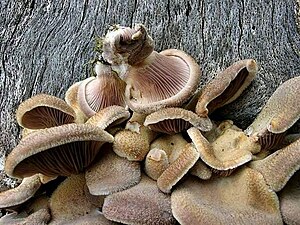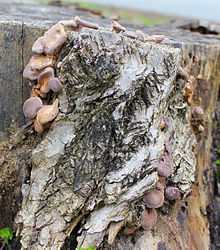Bristly ball
| Bristly ball | ||||||||||||
|---|---|---|---|---|---|---|---|---|---|---|---|---|

Bristly tangle ( Panus neostrigosus ) |
||||||||||||
| Systematics | ||||||||||||
|
||||||||||||
| Scientific name | ||||||||||||
| Panus neostrigosus | ||||||||||||
| Wood turner-Santos & Wartchow |
The Borstige Knäueling ( Panus neostrigosus , Syn. Lentinus strigosus ) is a species of fungus from the family of Stielporlingsverwandten (Polyporaceae).
features
The fruiting bodies of the mushroom are fan-shaped to kidney-shaped and are often tufted, the conspicuously bristly hairy or felty hats are 2–7 cm wide, they are purple-violet in color when young and fade to reddish-brown to ocher-yellow with age. The narrow, crowded lamellae are yellowish-white in young fruiting bodies and ocher-colored in older ones and run down the stalk. The spore powder is colored cream to ocher. The very short (1–3 cm long and 0.5–1 cm wide) stalk is pale (gray or lightly loose) and hairy to bristly, it can also be completely absent. The flesh (trama) is white and leathery. The mushroom initially tastes like flour, later bitter and astringent .
ecology
Like all saw blades, the bristle knot is a saprophytic wood inhabitant, it colonizes hardwoods, in Central Europe especially beech , oak and birch , but can also occur on other hardwoods, rarely conifers. The bristle knot is a warmth and sun-loving species that rarely occurs in closed forests; it can be found in clearcuts, clearings and on south-exposed, warm, light hedges and forest edges.
distribution
The species is almost cosmopolitan, it was found in Australia, South and Southeast Asia, tropical Africa, South, Central and North America. In the Holarctic , it occurs mainly in Mediterranean areas and is rare in temperate climates. Accordingly, it is found in Europe mainly in the south and quickly becomes rare in the north, in Germany it is present in all federal states with a focus in the south, but very rare in some areas. Krieglsteiner states that the number of bristles in Baden-Württemberg increased significantly towards the end of the 20th century, which is attributed to the warming and urbanization of the landscape.
meaning
The bristle ball is not suitable as an edible mushroom, as a wood destroyer it is economically insignificant.
swell
literature
- German Josef Krieglsteiner (Ed.), Andreas Gminder : Die Großpilze Baden-Württemberg . Volume 3: Mushrooms. Leaf mushrooms I. Ulmer, Stuttgart 2001, ISBN 3-8001-3536-1 .
- E. Horak : Bolete and agaric mushrooms in Europe . 6th completely revised edition, Elsevier - Spektrum Akademischer Verlag, Munich 2005
Individual proof
- ^ E. Ricardo Drechsler-Santos, Felipe Wartchow, Victor RM Coimbra, Tatiana B. Gibertoni, M. Auxiliadora Q. Cavalcanti: Studies on lentinoid fungi (Lentinus and Panus) from the semi-arid region of Brazil . In: Torrey Botanical Society (Ed.): The Journal of the Torrey Botanical Society . tape 139 , no. 4 , October 2012, p. 437-446 , doi : 10.3159 / TORREY-D-12-00019.1 .
